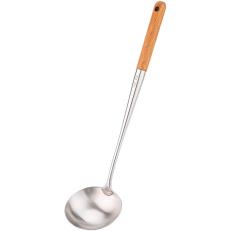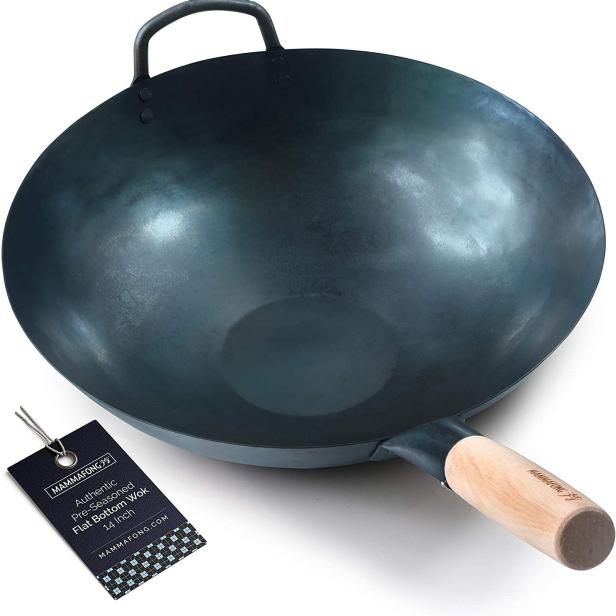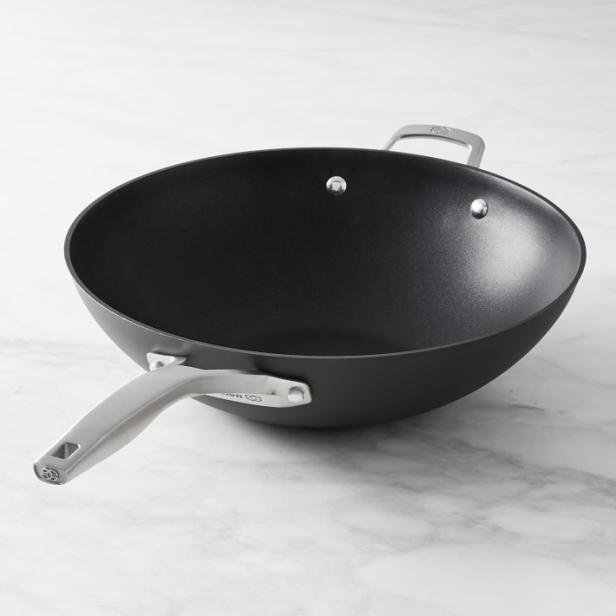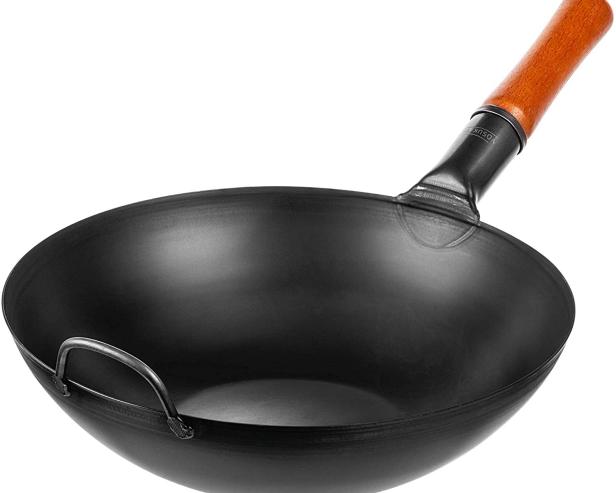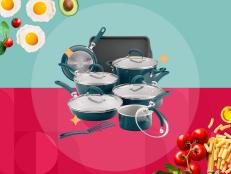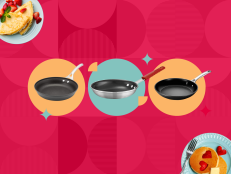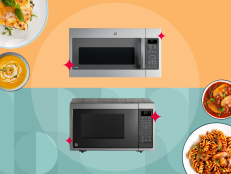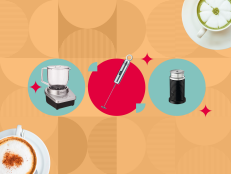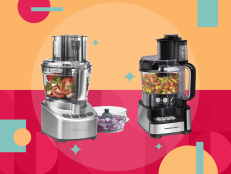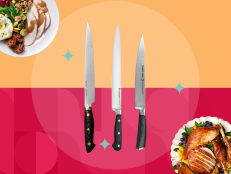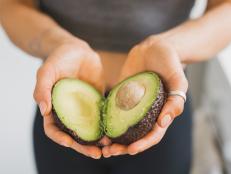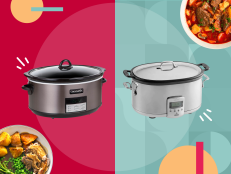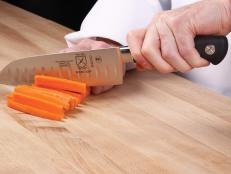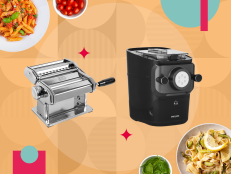5 Best Woks of 2024, Tested and Reviewed
We stir-fried chicken teriyaki to find the best woks on the market.

Our Top Wok Picks:
- Best Overall: Mammafong Preseasoned Carbon Steel Wok
- Best for Beginners: Calphalon Premier Nonstick Wok
- Best Nonstick (and Budget-Friendly): T-fal Nonstick Wok
- Best Carbon Steel (and Budget-Friendly): Yosukata Carbon Steel Wok
- Best for Camping: Lodge Pro-Logic Cast Iron Wok
Tested by Andy Liang for Food Network Kitchen
Woks are believed to have been invented more than 2,000 years ago in China during the Han Dynasty. There are many theories as to why woks were invented and remain so popular today: One is versatility; the wok can perform many cooking techniques using the same ingredients. Another theory is portability and design; in the past, tribal people would use a wok as their only cooking utensil because of its versaility and ability to hold a lot of food at one time. The design of the wok makes it a popular choice as a daily cooking utensil because it cooks food quickly and requires just a small amount of oil.
During testing we found that our favorite woks shared some key characteristics. When it comes to the design of the wok, the long handle shouldn’t be angled too high as it may obstruct a wok lid from fitting properly. We also preferred a wooden rounded handle as it provided the best grip during tossing. If the wok is light enough, a helper handle isn't necessary. Additionally, there shouldn’t be a deep angle where the flat bottom meets the sloping sides as you might hit the corner during stir frying and chip off the seasoning. Finally, we prefer carbon steel for most woks as the material heats up and browns food faster than any other material.
This article has been reviewed since its original publish date for accuracy, pricing and availability. We stand by our list of top wok picks.

Andy Liang
How to Use a Wok
You’ll want a wok you can toss. In addition to a fun performance for dinner guests, tossing a wok adds an important element in Chinese cooking called wok hei (directly translates to “wok air”). Wok hei refers to the subtle smoky or caramelized flavor that food gets when it’s tossed in a wok and catches some of the smoke from the burner. This is the flavor every Asian family looks for in stir fried dishes they order at a restaurant. Check out this video below to watch Chef Ming Tsai demonstrate proper tossing technique.
Woks are traditionally used on gas stovetops because it can help with the wok hei flavor as the food gets tossed in the air. Gas burners also reach higher up the sides of the wok compared to electric or induction burners. You may be able to use flat-bottomed woks on induction or electric burners, but it will not achieve the same result as cooking over a flame.
Woks can do everything that a flat bottom sauté pan can — and more. Browning happens very quickly in a screaming hot carbon steel wok, and browning equals flavor.
Woks aren’t always used for stir frying. You can use a wok to steam food including dumplings, buns, whole fish and more. When steaming, use a small metal rack (like this steamer rack) and a large wok lid. Fill the wok with water just up the top of the steamer rack, add the wok lid and bring to a boil. (Always place the item you want to steam on a heatproof plate to keep the plate from breaking due to the high heat.) When your food is done steaming, use a pair of tongs and oven mitts to remove it from the wok.
You can also use a wok to deep fry. It requires a bit less oil than deep frying in a Dutch oven. Plus, the oil heats up faster due to the thinner carbon steel material, and thanks to the high sloping sides, it can be a cleaner frying experience.
My family also uses a wok for stewing lamb, braising pork belly, pan frying whole fish or chicken, boiling dumplings, blanching vegetables, searing a steak, and even smoking a quail. The possibilities are truly endless!
Don’t put it in the oven. Woks with wooden handles are not designed to go in the oven. And it is very dangerous to place a round bottom wok in an oven with flat racks. We don't recommend putting any kind of wok in the oven, ever.
Wok Cooking Tools
Thanks to the versatility of a wok, you’ll need some tools to make the most of it.
Wok Turner: You will need a spatula to stir fry or move food around in the wok. We recommend this wok turner as a beginner spatula, as it’s easy to maneuver with the wok’s design.
Wok Ladle: You may have seen professional chefs use a ladle as their way of stir frying their food. For many home cooks, it is an adjustment as scooping the food out of the wok is done by picking up the wok with one hand and moving the food with the ladle to a plate or bowl.
Wok Ring: If you purchase a wok with a round bottom, you may need a wok ring to support the pan while cooking.
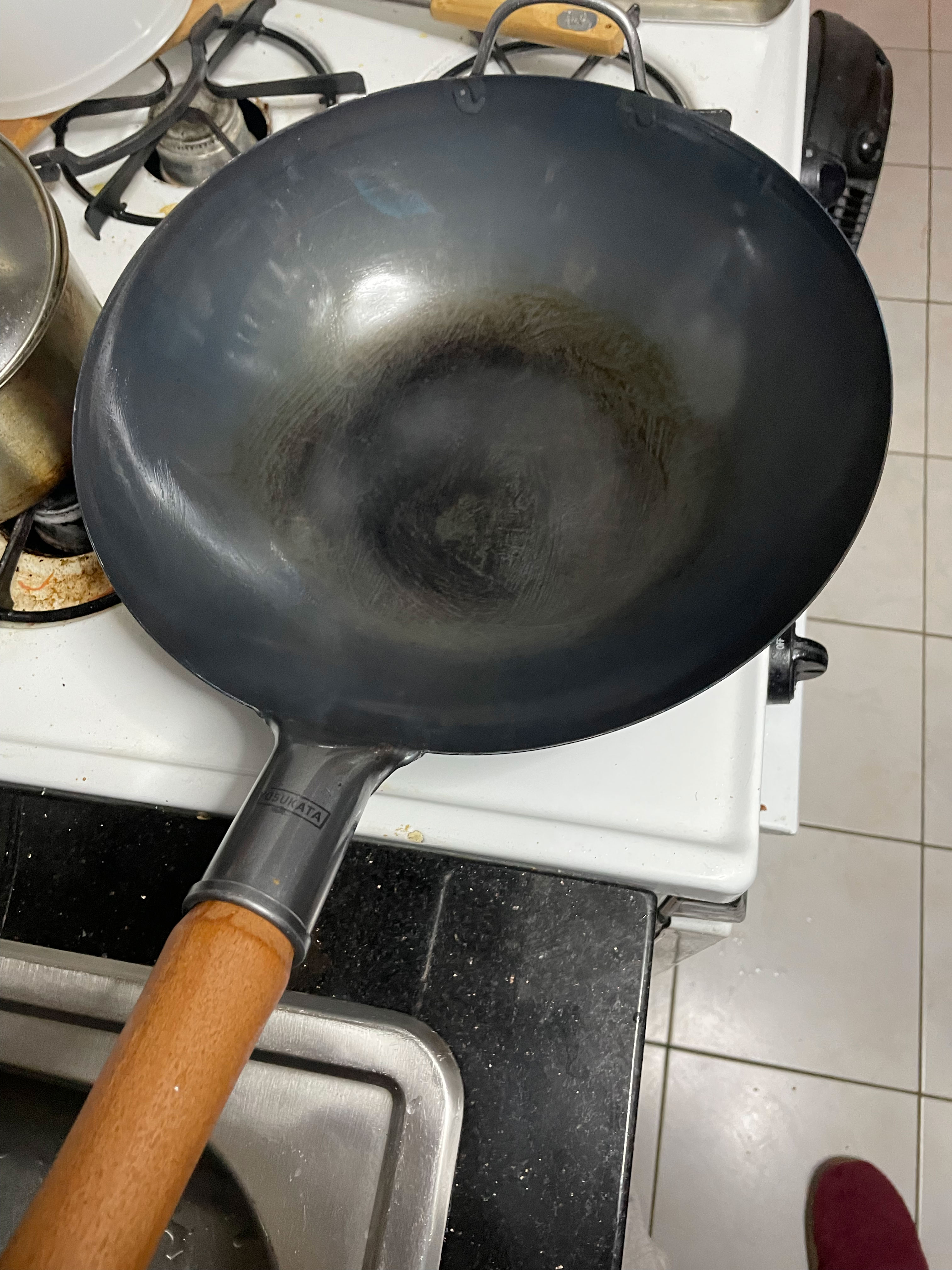
Andy Liang
What To Know About Wok Design
Flat Bottom Wok vs Round Bottom Wok
The two different wok bottom designs are flat or round bottom. The flat bottom works well with any stovetop burner rack since it will be stable while cooking. Some flat bottom woks can have a large diameter flat bottom that looks almost like a sauté pan with high sloping sides. Round bottoms will need a wok ring to support the wok on the stovetop. As for heating, flat bottom woks will have more of a concentrated heat source in the middle (typically the entire flat bottom and some sloping side), while the round bottom will have a larger heat ring that can cook and caramelize more food faster compared to a flat bottom. The main thing to consider when buying which type of design is whether you need or want to have a wok ring on top of your existing stovetop. If you’ve purchased a flat bottom wok, test it on a cold burner by putting some weight on one side and let go. If the wok leans to the side too much, you may need a wok ring to stabilize the wok so it is safer to cook with.
How to Pick a Wok Material
Early models of the wok were made of cast iron metals, which made them durable and long lasting, but heavy to carry. Modern woks are made from carbon steel, which makes them durable, nonstick, and light to pick up compared to cast iron.
Carbon steel is a special type of steel with a higher concentration of carbon then other types of steel. It is also very light compared to stainless steel pans. Carbon steel pans, including carbon steel woks, require seasoning as they tend to rust very easily. Carbon steel woks are very popular as they heat up quickly (some up to 700 degrees F), have a natural nonstick coating when seasoned properly, and are light enough to pick up with one hand.
Stainless steel does take a little longer to heat up compared to carbon steel, but can heat evenly. Since stainless steel retains heat, it can brown food nicely just like the carbon steel, but it will take longer. Stainless steel does not have a nonstick coating, so it will need more oil compared to carbon steel pans. Stainless steel woks tend to be very heavy, so it will be difficult to toss the food in the air to get the wok hei flavor. We did not find any stainless steel woks to outperform our top picks.
Nonstick woks are very good for beginners. You can adjust to using the sloping sides of the wok, practice tossing with one (or two) hands since nonstick material tends to be on the lighter side, and best of all, nothing sticks! There are a few restrictions when it comes to using nonstick cookware: Do not cook over high heat, do not let the wok smoke, do not use any metal utensils, and do not shock the pan in cold water after cooking. When working with nonstick woks, we found food took longer to brown, we used less oil than other materials, and nothing stuck to the pan — even sticky sauces.
Cast iron is a heavy material and you’ll need two hands to pick up a cast iron wok — a helper handle comes in handy here. Cast iron woks have the same characteristics as cast iron pans with a larger surface area to cook food. In a cast iron wok, you can toss very easily using a spatula or wok turner, but the wok will not move due to its weight. The cast iron heats up slowly, but when it’s ready, cooking goes very fast due to superior heat retention. Nothing sticks to the cast iron due to the natural nonstick coating developed through proper seasoning.
A note about handles: Some woks have wooden handles and metal handles. Some of those handles will be round or have angles. We prefer woks with wooden rounded handles to maintain a good grip while holding the wok in one hand, and using the other hand with a spatula to transfer the food onto a plate. We found rounded metal handles slip and it can be dangerous while transferring hot food to a plate.
Mammafong Preseasoned Carbon Steel Wok is beautifully designed. It is a flat bottomed wok with about a 4-inch diameter (which fits in all types of burners), gentle sloping sides, wooden handle that stays cool to the touch, and a helper handle just in case you have too much food inside the wok. Even though the wok arrived preseasoned, the manual still recommends seasoning. This wok gets up to 500 degrees F around the flat bottom, so the chicken and vegetables almost instantly browned. Additionally during stir frying and tossing, the wok turner had a natural glide so we didn't hit the corner or bottom of the wok which could potentially damage the seasoning. The chicken teriyaki sauce didn’t stick at all, chicken was very juicy, the vegetable remained crisp-tender and also had a bit of the wok hei flavor. We cleaned this carbon steel wok immediately under hot water with a scrub brush; everything released with minimal elbow grease.
The Calphalon Nonstick Wok is lighter than a standard carbon steel wok. It is a flat bottom wok with a metal angled handle. Its design is similar to that of a classic wok with gentle sloping sides so it curves to the motion made during stir frying. This wok should be used over medium heat with non-metal utensils as it's a nonstick material. The metal handle on this wok isn’t rounded, so there is a good grip while stir frying or transferring food onto the plate or cleaning. This wok was light enough for us to toss with one hand, but if you don’t think you can hold it with one hand, there is a helper handle so you can hold the wok with confidence! The chicken teriyaki had some caramelized bits on the chicken and all of the sauce glazed each piece of chicken and none of it stuck onto the wok. This wok is on the expensive side so cooking over medium heat and using non-metal utensils will prolong the life of this wok.
The T-fal Nonstick Wok is the lightest wok we've ever worked with. The wok’s design has a small flat bottom, and a classic gentle slope of a traditional wok. The manual says to clean, dry with a towel, and season the wok even though it is nonstick. We followed the seasoning instructions before cooking: Heat the wok over medium heat for 1 minute, spread a thin layer of neutral oil, heat the wok over medium heat for 1 minutes again. During cooking, the wok took a while to get hot enough to caramelize the teriyaki sauce or to brown the chicken. The stir fried vegetables were a bit softer than other woks but it isn’t unpleasant. This wok will take an extra 5-8 minutes to finish cooking the food. That said, for the price, this wok is a solid nonstick option.
The manual for the Yosukata Carbon Steel Wok provides information about wok hei or wok chi, what to do before cooking, and the seasoning process. This is the only manual that included the advanced way of seasoning carbon steel wok, which is stir frying some chopped aromatics like scallions, ginger, and potatoes for a few minutes to remove the metallic taste of the dishes cooked from the first few times. This wok comes with a factory coating that prevents rusting during transportation that takes about 3 minutes and some elbow grease to scrub off. As for cooking, the wok heats up to 750 degrees F in about 4-5 minutes. Since the wok gets very hot, the chicken and vegetables brown very quickly and the vegetables are crisp tender. When the teriyaki went in, nothing stuck to the wok and it glazed the chicken and vegetables. The vegetables and chicken have more of the wok hei flavor compared to the chicken teriyaki cooked in nonstick pans. Cleaning the wok was super easy; nothing stuck onto the pan due to the seasoning process, and light scrubbing with hot water was all we needed to get the pan clean.
The Lodge wok arrives already seasoned but the packaging recommends to season one more time. We seasoned the pan the same way we would a cast iron skillet. It’s design is very similar to a larger carbon steel wok with two small helper handles on opposite sides due to the weight of cast iron. There is the classic round bottom on the inside of the wok but the outside of the wok has a “foot” or flat bottom that allows the wok to sit on top of the burner without the use of a wok ring. This wok takes a long time to heat up (about 7-8 minutes) to get to 420 degree F, but once the wok is heated, it stays hot. When we cooked the chicken teriyaki the chicken didn’t stick, the vegetables were tender, and there were some brown spots. This wok weighs 11.5 pounds, so it's not designed for hand-tossing. Afterwards the clean up was pretty easy, nothing stuck to the wok but some sauce remained on the wok after transferring the cooked food to a plate. After removing the stuck on sauce, we seasoned the wok to prevent rusting.
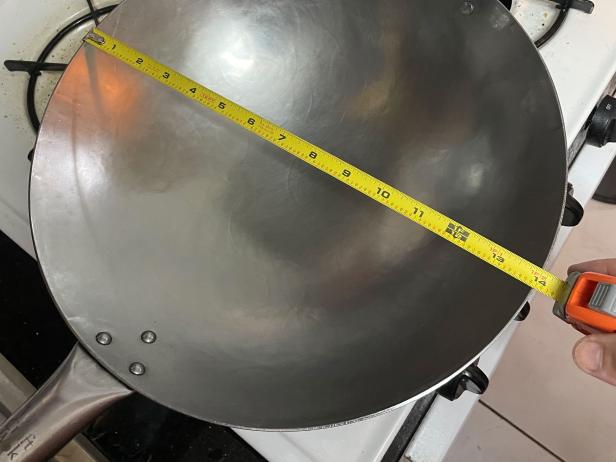
Andy Liang
How We Tested
Part 1: Product Intake and Pre-Use
We took all woks out of their packaging and looked for a manual or instructions on how to maintain the wok. We washed or seasoned all woks according to package instructions. Nonstick and stainless steel woks were washed with with soapy warm water. Carbon steel woks were washed under soapy warm water to clean off the “plastic” coating, which protects the wok from rusting during shipping. Afterwards, we dried and seasoned the carbon steel wok by heating it up until it smoked over high heat. Once it was smoking, we turned off the heat and spread a thin layer of neutral oil (like vegetable or grapeseed oil) using a paper towel. We followed instructions to clean cast iron woks with warm water, dry, heat over high heat until smoking (to evaporate more moisture just in case), add 1 teaspoon of neutral oil, spread a thin layer of oil with a paper towel, and heat over high heat until smoking again.
Part 2: Food
Every single wok went through a test of cooking Chicken Teriyaki with stir fried vegetables. We chose Chicken Teriyaki since it involves a sticky teriyaki sauce, browning chicken, brown mushrooms (for stir fried vegetable), and stir frying bok choy, carrots, and broccoli from raw to keep the crisp but still tender texture.
Part 3: Cleaning
Nonstick woks only need soapy warm water to clean and dry with a towel. As for carbon steel and cast iron woks, the cleaning is a bit more involved: Both are the same steps. Start by washing the wok in warm water only (no soap as it can remove some of the nonstick coating or patina), dry with a towel, heat over high heat until smoking, add 1 teaspoon neutral oil, spread thin layer of oil using a paper towel only on the inside of the wok, and heat over high heat until smoking again. This protects the wok from rusting over time and creates a thicker nonstick coating.
























